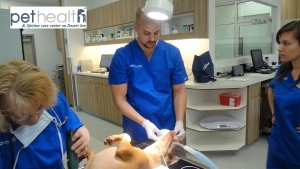What Happens During A Veterinary Dental Cleaning?

As a responsible pet owner, you always have the best interest of your pet in mind, and you want them to remain as happy and healthy as possible. Even though it is not necessary for animals to brush their teeth the way that humans do, a periodic dental exam and cleaning can assist your pet in avoiding very serious complications that can make them quite unhealthy. Additionally, your pet may have cracked or broken teeth that are causing them pain and discomfort. This is quite common due to animal’s tendencies to chew on hard toys like hooves, bones, and hard rubber playthings. A comprehensive dental examination and cleaning for your pet can provide long-term benefits to their health.
What to expect from the veterinary cleaning.
The initial exam is generally an awake examination of the dog or cat’s mouth and teeth. Sometimes this is quite difficult due to the desire of the dog or cat to avoid anything going into their mouth, so some pets will provide a better awake exam than others. This exam allows the veterinarian to get a general idea of the condition of the pet’s mouth, teeth and gums, and tongue. At this time, the pet will probably need to have blood drawn to identify any potential issues that could complicate the process, and will determine if the pet is healthy enough to undergo anesthesia.
After this point, the pet will be anesthetized. This is a troublesome time for many pet owners, who experience anxiety knowing that their pet is asleep. The best advice for pet owners is to learn as much as possible about the anesthesia process before their pet is anesthetized so that they know what to expect and in what time frames. Anesthesia performed by a professional veterinarian under the necessary protocol is generally very safe. There will also be a local anesthetic administered into the pet’s mouth so that the animal will experience less pain and improve the safety of the procedure by allowing a quicker recovery time. While the pet is under anesthesia and the dental cleaning is going on, they are not experiencing any pain. Any pain that is encountered by the pet will be as a result of procedures that were necessary during the cleaning and can last several hours after the pet is awake.
During the dental procedure, radiographs (x-rays) will be taken so as to identify any issues below the gum lines. These images help identify issues that are not visually apparent, like broken teeth or dead roots, periodontal disease, or infections. A full cleaning much like the ones that people get is next. The veterinary dentist will clean the pet’s teeth both above the gum line and below the gum line using special dental instruments that will remove tartar and plaque. The dentist then professionally scales and polishes any part of the pet’s teeth that is visible and repairs any damaged teeth that need repair. There may also need to be the removal of teeth that are damaged beyond the point of repair.
After the animal has recovered and is awake, they can generally go home after a short observation period. In most cases, they can eat and drink as normal upon release, but the veterinary dentist will provide a full report of recommendations that are specific for your pet. Follow these instructions carefully so as to reduce any pain or discomfort that your pet might feel, and prepare to keep an eye on your pet for upwards of a full day as they will possibly be very disoriented after the anesthesia. They may whimper, cry and act in a way that is strange as they are unsure of what is going on, and are confused. This is normal, and resting in a comfortable environment should return your pet to normal within a short period.
